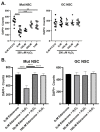LRRK2 Attenuates Antioxidant Response in Familial Parkinson's Disease Derived Neural Stem Cells
- PMID: 37947628
- PMCID: PMC10648992
- DOI: 10.3390/cells12212550
LRRK2 Attenuates Antioxidant Response in Familial Parkinson's Disease Derived Neural Stem Cells
Abstract
Parkinson's disease (PD) is the second most prevalent neurodegenerative disease, characterized by the loss of midbrain dopaminergic neurons which leads to impaired motor and cognitive functions. PD is predominantly an idiopathic disease; however, about 5% of cases are linked to hereditary mutations. The most common mutation in both familial and sporadic PD is the G2019S mutation of leucine-rich repeat kinase 2 (LRRK2). Currently, it is not fully understood how this mutation leads to PD pathology. In this study, we isolated self-renewable, multipotent neural stem cells (NSCs) from induced pluripotent stem cells (iPSCs) harboring the G2019S LRRK2 mutation and compared them with their isogenic gene corrected counterparts using single-cell RNA-sequencing. Unbiased single-cell transcriptomic analysis revealed perturbations in many canonical pathways, specifically NRF2-mediated oxidative stress response, and glutathione redox reactions. Through various functional assays, we observed that G2019S iPSCs and NSCs exhibit increased basal levels of reactive oxygen species (ROS). We demonstrated that mutant cells show significant increase in the expression for KEAP1 and decrease in NRF2 associated with a reduced antioxidant response. The decreased viability of mutant NSCs in the H2O2-induced oxidative stress assay was rescued by two potent antioxidant drugs, PrC-210 at concentrations of 500 µM and 1 mM and Edaravone at concentrations 50 µM and 100 µM. Our data suggest that the hyperactive LRRK2 G2019S kinase activity leads to increase in KEAP1, which binds NRF2 and leads to its degradation, reduction in the antioxidant response, increased ROS, mitochondria dysfunction and cell death observed in the PD phenotype.
Keywords: Parkinson’s disease; induced pluripotent stem cells; neural stem cells; single cell transcriptomics; target identification.
Conflict of interest statement
MMD is founder of NeoNeuron LLC.
Figures








References
-
- Braak H., Braak E., Yilmazer D., Schultz C., de Vos R.A., Jansen E.N. Nigral and extranigral pathology in Parkinson’s disease. J. Neural Transm. Suppl. 1995;46:15–31. - PubMed
Publication types
MeSH terms
Substances
Grants and funding
LinkOut - more resources
Full Text Sources
Medical

